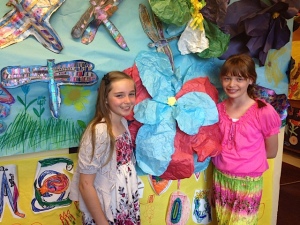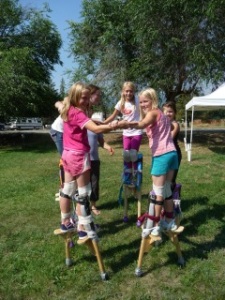
Grandstreet Theatre’s production of Disney’s Beauty and the Beast. Photo by Jeff Downing
This morning I had coffee with my friend Marianne Adams, who is the long-time education director at Grandstreet Theatre in Helena. Grandstreet has been around since the ’70s, operating out of a beautifully-restored old church in downtown Helena. Since the early ’80s, they have had a thriving after school program, Grandstreet Theatre School. I was a part of this program in high school, and am one of many young people that Marianne took under her wing and helped launch into successful adult lives. Marianne told me a story this morning that reminded me of what great arts education programs like Grandstreet do to help create future leaders, thinkers and innovators.
It is Christmas show season at Grandstreet. Each year, Grandstreet produces a huge show for the holidays on their mainstage season that features students from the Theatre School. Students perform on stage in large and small roles, they usher, they run the light board, they sing in a preshow choir, they help backstage. Students are given a huge amount of responsibility in the success of the show. In order to offer more opportunities, Grandstreet double casts the production–meaning Marianne and her team somehow manage to rehearse and organize two giant casts of kids ages kindergarten through high school for three solid weekends of mostly sold-out performances. It is a monstrous and exhausting venture. The productions I participated in when I was in high school–Peter Pan, Charlie and the Chocolate Factor, Pinnochio–are where I bonded with some of my life-long friends and created some of my best holiday memories.
This year they are doing Disney’s Beauty and the Beast, a show with some pretty hefty singing roles for young men, particularly the role of Gaston, the hyper-macho buffoon who unsuccessfully tries to win Belle. As any small town high school drama teacher can tell you, finding high school boys who can sing, act and dance and are willing to get on stage in front of a bunch of people and exude confidence can be a real challenge. The Theatre School put nearly every teenage boy in their casting pool to use, and chose to bring in a professional actor to play the Beast.
During the second weekend, the director’s nightmare happened: the actor playing Gaston got sick, too sick to perform. Marianne got the call on Saturday morning, and with no understudy assigned, had to make a decision about who to send on for a 2:30 pm matinee. At 9:00 am, she called one of her teenage chorus members, a young man named Travis, an active member of the Theatre School, but one who had not yet played a major role. She knew he sang well, but he had not had a knock-out audition. She was taking a real chance, but her other strong male actors were already cast in larger roles. A half-hour later, he was on the set with a script in hand, walking through the blocking and learning his dialogue. At 2:30 pm, he went on as Gaston, only hiding his script on a table for one scene where he was shaky on the lines. He went on again at 7:30 pm that evening.
Beaming with pride in Travis’ accomplishment, Marianne told me about the curtain speech she gave that evening, explaining to the audience that Gaston would be played by an understudy. She explained to them how Travis had jumped with both feet into the role just hours before. And, she told the audience that if they ever wanted to hire somebody, they should hire a person like Travis who has studied theater, because “they work HARD, they work FAST, and they are BRAVE.”
Imagine you own a business, or are working on a huge project for your organization, and a crisis rears its ugly head. The pressure is on, deadlines need to be met, solutions need to be found, income and jobs are on the line. Who do you want on your team? I’d pick the person who works hard, works fast, and is brave. I’d pick a Travis. Travis may or may not have a future career in theatre. But Travis will enter the working world with the skills he gained through his high school participation in theatre, where he was put to the ultimate test and rose to the challenge, and no doubt employers in any field he chooses will recognize him as an asset.
“We are such good employees,” says Marianne, referring to people who have studied theatre. Seventy-two percent of business leaders say that creativity is the number one skills they are seeking when hiring. Students who have studied the arts bring that creativity and innovation, and they also bring punctuality, resilience, persistence, grace under pressure, collaboration and a multitude of other habits of mind employers also need. Employers–go hire yourself a Travis!




